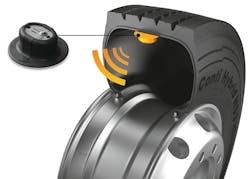Continental spotlights smart tires, monitoring systems at NACV
Global automotive supplier and tire manufacturer Continental used its space the at the North American Commercial Vehicle Show to display its latest and most innovative technology for commercial fleets, including the new intelligent-capable regional steer tire, as well as a new GHG 2-compliant monitoring solution.
“In 2019, Conti has given the tire a voice,” said Tom Fanning, vice-president of sales and marketing-North and Central America at Continental Tire. “Today, we’re communicating actionable intelligence outside the vehicle. Everyone is aware of what’s going on with that truck.”
Continental offers a wide portfolio of intelligent-capable steer tires—important because the steer tire is safety critical—which can be ordered pre-equipped with TPMS sensors from the factory.
Conti HSR 3, Continental’s newest steer tire, is a regional steer tire designed to deliver excellent mileage with scrub resistance. It will replace the HSR2 in regional steer usage, delivering higher mileage than its predecessor, the company said. The Conti HSR 3 is built on the Conti 3G casing for improved durability and retreadability, essential elements for delivering the lowest overall driving cost to regional fleets.
The key differentiator between the popular HSR2 predecessor and the new Conti HSR 3 is the enhanced belt package of the new product. With significant engineering improvements, it withstands highly concentrated pressure and increases penetration resistance. Built for increased stiffness, it reduces heat build-up for improved wear and longer mileage. This also extends the casing life for enhanced retreadability.
The Conti HSR 3 is undergoing field testing, including a refrigerated food service fleet in Pennsylvania. Competitor products were expected to deliver 160,000-180,000 miles, according to the fleet. The Conti HSR 3 is currently projected to deliver more than 220,000 miles under the same conditions.
In addition to the new Conti HSR 3, Continental offers a full portfolio of intelligent-capable steer tires, customized to the needs of fleets in different applications, including the Conti EcoPlus HS3, Continental’s most fuel-efficient steer tire; Conti HSL 3, Continental’s steer tire for long haul and super-regional applications; and Conti HSC 3, a heavy truck, steer/all-position, construction tire.
Monitoring systems
Continental offers a full portfolio of digital tire monitoring systems to meet different fleet needs. Components of all systems can be combined to take advantage of different functionalities.
Tire monitoring solutions include the ContiPressureCheck on-vehicle TPMS and ContiConnect Yard digital tire monitoring system with web portal.
ContiPressureCheck Solo, a trailer TPMS system, is the company’s newest tire monitoring solution. The simple and low-maintenance solution for trailer tire monitoring notifies the driver of tire pressure issues in real-time while keeping the trailer system completely separate from the tractor. ContiPressureCheck Solo offers fleets a solution to reduce trailer tire costs and stay compliant with pending greenhouse gas regulations from the EPA, National Highway Traffic Safety Administration, and California Air Resources Board, according to Continental.
ContiPressureCheck Solo is made of three major components. Continental tire sensors form the basis of all of the company’s commercial tire monitoring solutions. Mounted on the inner liner of each tire, they are protected from weather, theft, curbing, and damage during tire mounting. Sensors can be retrofit into existing tires, or intelligent tires with preinstalled sensors can be ordered directly from the Continental factory.
The Central Control Unit, mounted on the trailer, continuously receives data from the tire sensors and activates alerts if needed.
The notification light, mounted in an industry-standard position and visible in the driver’s side mirror, is activated if low pressure is identified in any of the trailer’s tires. Multiple levels of low-pressure alerts ensure notifications reflect the severity of the issue.
Trailers equipped with telematics systems can also transmit tire data into the telematics dashboard, allowing back office support personnel to view trailer TPMS information remotely.
